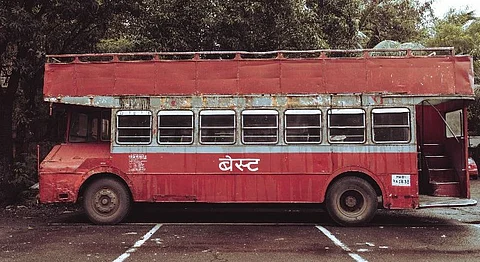
- #HGCREATORS
- #HGEXPLORE
- #HGVOICES
- #HGSHOP
- CAREERS
- ABOUT US
- CONTACT US

Many people in the city who use buses as their mode of transport are all too familiar with BEST- Brihanmumbai Electricity Supply and Transport services. What they usually don’t know, however, is that they have as many as three double decker buses just for trimming trees around the city. Named the ‘Vruksh Chaantni Vahan’ or Tree Trimming Vehicle, it is one of the many BEST buses that is not for passengers.

The Public Relations Officer, Hanumant Gophane, in the Colaba BEST office believes that these tree trimming vehicles have been doing the rounds of the city and trimming unruly branches ever since the first double-decker was launched in 1937. According to the documents, the first written account of these buses has been found in 1982.
“The double decker buses that have been phased out are altered and turned into these buses. Before they are turned into scrap, we use these buses for this purpose with RTO permission,” said Mr. Gophane. Usually, a 15-year-old bus is taken off of roads but not these ones. He said that the reason to have these buses increased with the growth of cars and vehicles on the road. “Buses get hit by branches and may cause damage to certain parts. Windows break, metal gets scraped and the body is damaged. That doesn’t worry us much as passenger safety, if people get hit by tree branches while sitting in the bus, it could be lethal,” he said.
With their own set timetable, these three buses do the rounds in their divisions with the station manager of each depot. Within the western, eastern and city suburbs of Mumbai, these tree trimming buses with an open top deck of a double decker, move around the areas that have been reported by drivers. A bus driver has to make a complaint regarding any tree branch or foliage that is obstructing the vehicles movement. The depot manager takes note of all the bus route complaints and take this vehicle to these spots once every month. Every day, the bus is in some part of the city with several bus employees trying to trim branches with on-going traffic. The bus is also used for cleaning bus queue shelters at various stops.
L.K Khade has been on every single trip of one of these buses that has Mumbai Central as its main depot. Working as a tree trimming supervisor with the bus since 2005, Khade knows the challenges that comes with trimming the branches. “We begin our work early morning after 8 a.m and the depot manager from every depot in this zone comes with us each month on a rotational basis. He knows which tree needs to be trimmed in which area. The most difficult part is to trim a tree in such a way that the branch and foliage falls inside the bus and not on the road. There are people walking below and traffic all around us, we have to work quickly and ensure that the trimmings don’t fall out of the bus. If there is too much traffic and we are holding it up, we try to finish as soon as possible and sometimes make a second trip to trim it properly,” he said. “It is expensive to fix damaged parts and when people come to claim medical expenses if they get hurt inside a bus, it costs lakhs to the company,” he stated.
One bus has at least seven to eight people on board for the trimming purposes. A bus route Mistry (in charge of the bus, like Khade,) three Nawghanies or labourers, a gardener from the BMC department, A driver and a traffic inspector from the traffic department and a civil department worker are needed to complete this task. Once the trimming process is complete, the foliage is taken to the empty BEST property in Trombay and dumped there. “The Mali who is requisitioned from the local Ward Office does the actual pruning of branches fouling the carriage way of our buses. In case there is a need to cut barks or branches, permission is acquired from the Superintended of Gardens,” said a traffic department report.
The busiest time for the buses is monsoon as most trees in the city bend down during this period. Khade informed that once the bus is modified, it is used for a few years before being sent to the scrap yard. “The current bus is going to the scrap yard in two years,” he informed.
The three buses are stationed at Mumbai Central, Oshiwara and Anik Depots in the city and there are other buses that are used for painting work as well. The BEST also has street light repair buses that has come far from lighting gas lamps in colonial India when BEST was known as Bombay Electric Supply and Tramways, to repairing streetlights today. It also has canteen buses plying in the city that provides meals to BEST employees at certain spots.






Photos: Tanya Prasad
Words: Preksha Malu
